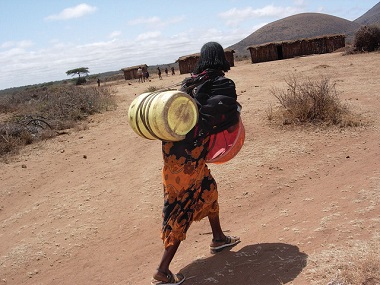The following post by IFPRI collaborator Hitomi Komatsu was originally published on the Agrilinks site.
Malnutrition is a severe problem, especially in poor households in developing countries. Many families are not well nourished because they do not have access to nutritious and diverse diets.
Studies have shown that one way to improve nutrition among rural households is to increase women’s engagement in farming. Increasing women’s control of food production or earnings and increasing their power to make decisions leads to better nutrition for their families, because women are more likely to spend their earnings on nutrition-enhancing purchases.
But there is a paradox: increasing women’s time in agriculture may also have an adverse effect on their own and their families’ nutrition, taking time away from nutrition-improving domestic work such as preparing food, feeding, childcare, collecting water and firewood, and engaging in good hygiene and sanitation practices. Intensifying women’s agricultural engagement is a concern if it leads to compromising their own nutrition or that of their children.
Does an increase in women’s time in agriculture actually have a detrimental effect on maternal and child nutrition? And does a reduction in women’s time in domestic work lead to poorer maternal and child nutrition? Using time use and nutrition data from Bangladesh, Cambodia, Ghana, Mozambique, and Nepal, my IFPRI colleagues and I examined these questions.
Asset-poor vs. non asset-poor women
First, we found that in nearly all the countries we studied, women with fewer assets women are more time-burdened than women who are not asset-poor: they spend more time cooking, caregiving, and doing other domestic chores—and engaging in agricultural and nonagricultural work—than their better-off counterparts.
In addition, we found that when women in poor households sacrifice domestic and cooking work to other tasks, the quality of their diet—and that of their children—suffers. However, in non asset-poor households, children’s dietary diversity was less sensitive to changes in women’s time in cooking or domestic chores. In other words, households with more assets achieve better nutrition outcomes with less time in domestic work than those with few assets. Therefore, ownership of assets—including access to electricity and safe water and sanitation—improves the overall impact of domestic work time on nutrition.
Local context matters
Our results varied depending on the country. Poor women spend more time in agricultural work than nonpoor women in all five countries, except Mozambique. These long hours in agricultural activities had a negative impact on the diet quality of all women—regardless of economic status—in Ghana, and of nonpoor women in Mozambique. But women working in agriculture actually improved dietary diversity for poor women and children in Mozambique, and for children in Nepal. In these two countries, agriculture is an important source of food and income for asset poor households. The results imply that the impact of time in agriculture on nutrition depends on social economic status and local context.
Careful interventions can help
To respond to these context-sensitive realities, those designing agricultural interventions should assess the gender roles in agricultural and domestic work, including identifying who controls what in the agricultural process.
This is especially important for poor women who are already time constrained. Interventions that increase women’s agricultural workload could have unintended consequences on nutrition because of the time taken away from domestic work. In contrast, interventions that save time in agricultural tasks could allow women, or men, to spend more time in nutrition-improving activities. Agricultural interventions could also impact existing gender roles, causing a negative or positive effect on nutrition depending on who controls the products or the income received from the products.
Regardless of the intervention, transforming gender norms—with men taking on a greater role in domestic work—could help reduce women’s work burdens, and improve the nutrition of the household.
Further reading:
Komatsu, H. et al. 2015. How Does Women’s Time in Reproductive Work and Agriculture Affect Maternal and Child Nutrition? IFPRI Discussion Paper 01486. Washington DC: International Food Policy Research Institute. http://www.ifpri.org/publication/how-does-womens-time-reproductive-work-and-agriculture-affect-maternal-and-child
Doss, C. R. 2001. “Designing Agricultural Technology for African Women Farmers: Lessons from 25 Years of Experience.” World Development 29(12): 2075-2092.
Headey, D., A. Chiu, and S. Kadiyala. 2012. “Agriculture’s Role in the Indian Enigma: Help or Hindrance to the Crisis of Undernutrition?” Food Security 4 (1): 87–102. http://link.springer.com/10.1007/s12571-011-0161-0.
Kadiyala, S., J. Harris, D. Headey, S. Yosef, and S. Gillespie. 2014. “Agriculture and Nutrition in India: Mapping Evidence to Pathways.” Annals of the New York Academy of Sciences 1331:43–56. doi:10.1111/nyas.12477.
Malapit, H. J. L., and A. R. Quisumbing. 2015. “What Dimensions of Women’s Empowerment in Agriculture Matter for Nutrition in Ghana?” Food Policy 52:54–63. doi:10.1016/j.foodpol.2015.02.003.
Ruel, M. T., and Alderman, H. 2013. Maternal and Child Nutrition Study Group. “Nutrition-sensitive interventions and programmes: how can they help to accelerate progress in improving maternal and child nutrition?.” The Lancet 382(9891): 536-551.
Smith, L. C., U. Ramakrishnan, A. Ndiaye, L. Haddad, and R. Martorell. 2003. The Importance of Women’s Status for Child Nutrition in Developing Countries. Research Report 131. Washington, DC: International Food Policy Research Institute. http://www.ifpri.org/publication/importance-womens-status-child-nutrition-developing-countries







